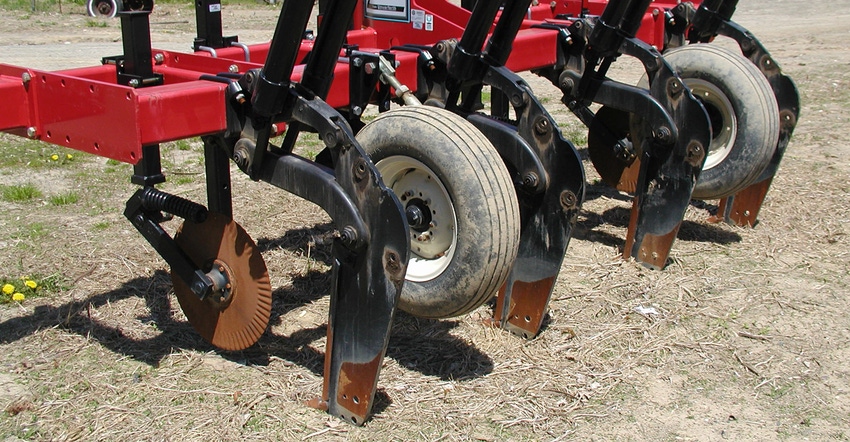October 21, 2019

After last year’s torrential rains and this year’s wet spring, this fall’s dry spell is offering an opportunity for farmers to alleviate soil compaction by subsoiling.
Soil compaction affects the physical, chemical and biological properties of soil. It leads to increased bulk density, reduced porosity, increased penetration resistance, and reduced water infiltration and percolation.
Reduced root growth in compacted soil leads to greater susceptibility to drought and can cause phosphorus and potassium deficiencies. Greater runoff leads to increased soil erosion and nutrient losses. Increased nitrogen losses are possible due to denitrification in soils that sit wet for too long. Ammonia volatilization of applied manure and urea is possible because the nitrogen does not soak into the soil as quickly.
Soil biological activity is also inhibited.
Before you get enthusiastic about tillage, though, you need to diagnose your compaction problem first.
Penetrometer
The soil compaction tester, or penetrometer, is one way you can detect compaction, but the absolute numbers on the gauge are meaningless since soil conditions are too dry.
Nonetheless, this probe can help you detect if you have a compacted layer and at what depth that ends. You detect it by pushing the probe into the ground. If there is a distinct layer of compaction, the resistance to the probe will suddenly decrease when you are through the layer. Determine at what depth that is so you can run a subsoiler just below that to remediate the compaction.
However, don’t rely on the penetrometer alone. Take a shovel and dig out some crop roots. If you see distinct thin layers or a massive structure and roots that grow horizontal instead of vertical, that is another indicator of compaction. If roots are clearly restricted at a certain depth, this may call for action.
Try to determine if compaction is limited to certain areas of the field. It is common for only head rows to be treated while the rest of the field may be left untouched.
Types of subsoilers
Modern subsoilers do not turn soil over. They have narrow shanks that are not parabolic and have attachments that help keep residue in place.
Some have large winged points that heave the soil and cause much fracturing of it, even between shanks. Others have narrow tips that are meant to only create a vertical slot for deep root penetration and water percolation while doing less fracturing between the shanks.
Para-till subsoilers have bent-leg shanks. The shanks come down straight then curve sideways on a 45-degree angle where the tip is again positioned downwards. Research at the Soil Dynamics Research lab in Alabama has shown that para-till shanks do maximum fracturing below the surface, take less power per shank than straight shanks and do minimum surface residue disturbance.
Choose attachments wisely
Contemporary subsoiling is meant to be a one-pass operation so that crops can be planted immediately after subsoiling without secondary tillage. The choice of attachment is crucial because it determines surface residue reduction to a large degree.
Soil tends to blow out behind the shanks — especially when run at higher speeds — so attachments are available to push soil back to create a suitable seed bed.
To achieve soil conservation goals, more than 30% residue cover should be present after subsoiling and planting. Attachments should not cover residue; they should leave it on top.
Kick-back mechanisms are another necessity on subsoilers. If not present, shear bolts will have to be replaced on a regular basis, especially in rocky soils, making subsoiling an arduous task.
Setting the shank
Next comes the depth at which the shanks should be set.
The subsoiler should be set approximately 1 inch below the compacted layer.
A tractor that can pull the subsoiler needs to be available. Depending on soil conditions, you should count on at least 40 to 50 hp per shank.
Rebuilding soil structure
Once subsoiling has been completed, you should have a plan in place to manage post-subsoiling traffic and build soil structure.
The benefits of subsoiling are easily lost by re-compaction with heavy equipment. In fact, the situation will be worse than before subsoiling because the subsoiled field is more susceptible to rutting. Therefore, use flotation tires on all equipment and reduce tire pressure as much as possible to benefit from a large footprint.
Do not exceed axle loads of 10 tons and limit repeated traffic to select areas of the field that can then be treated if needed. After subsoiling, plant cover crops to increase root mass in the surface and subsoil, and rotate crops with different root architectures such as tap-rooted and fibrous-rooted crops.
Source: Penn State Cooperative Extension, which is solely responsible for the information provided and is wholly owned by the source. Informa Business Media and all its subsidiaries are not responsible for any of the content contained in this information asset.
You May Also Like




